Burns Unbroke is a six-week programme composed of visual arts, music and performance. Although hugely contrasting in terms of the various mediums and approaches employed by the participating artists, at the core of the exhibition lies the legend of Robert Burns. Through their work, the artists examine and respond to the significance of Burns in today’s contemporary society and the longevity of his poetic influences. An emblem of Scottish national identity and an advocate of social and political change, Robert Burns has become an integral component of Scottish culture and heritage.
Fittingly, curator Sheilagh Tennant, who has been working closely with Burns-based artwork for some time now, has invited Scottish and British artists to formulate artworks representative of the Burns legacy. Including works by renowned practitioners as well as new and emerging artists, the show offers a rich variety of dimensions from which to perceive Burns. Whether it is the beautifully delicate marble sculptures of Douglas Gordon, daintily depicting a Tam O’Shanter and a hand holding a thistle, or the Chapman Brothers‘ grotesquely defaced version of the royal portraits found on pound notes, the theme of Robert Burns holds a patriotic magnetism throughout.
Given the breadth of work on display, it is impossible to trace a singular theme present throughout all artworks. However, by navigating the multiple floors in Summerhall, it becomes evident that the diversity of the show is what consolidates the exhibition. Gender, class, representation and self are merely a few of the themes explored and conveyed. Glasgow-based Ross Fleming draws on the iconography of Burns’ Tam O’Shanter poem by employing queer and fashion inspired ideas to shape his performance-based film. David Mach utilises everyday objects, adopting Tunnock’s Tea Cake wrappers as the medium in his portrait of Burns. Calum Colvin creates digital collages which manipulate preconceptions by fusing the familiar with the unfamiliar.
A work in the lower galleries by Rosie Dahlstrom reveals a gender-blurred portrait of Burns fusing the feminine with the masculine. Executed beautifully in oil paint, Dahlstrom’s work examines cultural symbols of sexuality. Alongside visual art, text and language are heavily present. Graham Fagen’s The Slave’s Lament is an eerie and mesmerising multi-channel video projection using Burns’ lyrics; the performed song draws curiosity as it echoes through the long corridors of Summerhall. Highly evocative and emotionally piercing, The Slave’s Lament, alongside the body of work brought together in the exhibition, bring Burns’ beautiful verse to life.
